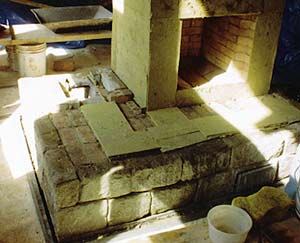Cold Hearth Syndrome But the biggest source of trouble is the location of the fireplace. Over the past 50 years of residential design, fireplaces have migrated from the center of the house to a position against the exterior walls, or even into chases that are completely outside the house. This causes cold hearth syndrome, which is the source of most fireplace failures. The most dramatic effect of a cold hearth is a predictable blast of cold air when the fireplace doors are opened to build a fire. Smoke tends to fill the room when someone tries to light a kindling fire. This is a common, even chronic, characteristic of North American fireplaces. The syndrome usually has its origin in the decision to place a fireplace outside an exterior wall in a frame or brick chase (Figure 2). Figure 2. Chimneys built on an outside wall, whether exposed or boxed with an uninsulated chase, are prone to downdrafting (top). One solution is to insulate the walls of the chase and to vent the chase to the interior so warm air can circulate (middle). The best solution is to locate the chimney properly in the first place. The ideal location is in the center of the house (bottom), because the surrounding air will keep the chimney warm and the chimney will penetrate the roof at its highest point. The cold outside air sucks warmth from the fireplace and chimney structure, causing the temperature of the air in the flue to drop. When the flue temperature is lower than the house temperature, air begins to flow down the chimney and onto the hearth. This is called a “cold backdraft” and contrary to common belief, it does not happen because cold air is heavy and falls down the chimney. The air is not falling — it is being sucked down by the house. Just as hot exhaust in a chimney produces a pressure difference called a “draft,” so the relatively warm air in a house produces a pressure difference called “stack effect.” The buoyant warm air rises, producing a slight low pressure zone downstairs and higher pressure upstairs. Since most fireplaces are installed on lower floors, they experience negative pressure due to stack effect when it is cold outside. As soon as the air in the chimney falls below room temperature, the house becomes a better chimney than the chimney itself, and a cold backdraft gets started. The backdraft tends to stabilize because as the chimney becomes full of cold air, it cannot produce any draft to resist the suction of the house.
Successful Fireplaces in Tight Houses
A central location, a tall chimney, and controlled combustion are the keys to a good burn
12 MIN READ
